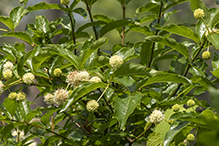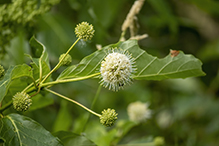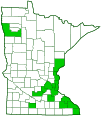buttonbush
(Cephalanthus occidentalis)
Conservation • Wetland • Description • Habitat • Ecology • Use • Distribution • Taxonomy
Description |
||
Buttonbush is a tall, deciduous shrub rising on multiple stems from a woody, branching, root system. Individual stems can be 3′ to 10′ tall and 1″ to 4″ in diameter at breast height, but in the northern parts of its range, which includes Minnesota, they are rarely more than 6′ tall and 3″ in diameter at breast height. The plant rarely takes the form of a small tree up to 16½′ (5 m) tall. Buttonbush occurs in the United States and southern Canada east of the Great Plains, in Mexico, and in Central America. There are also disjunct populations in Arizona and in California. It is uncommon in Minnesota, where it is mostly restricted to the floodplains of the Mississippi and St. Croix Rivers, and a disjunct population in Rice County. It is found in floodplain forests and shrubby swamps; at the edges of marshes and bogs; on river banks and lake shores; and in disturbed areas. It grows under full or partial sun in wet to moist areas on fertile soil with high organic content. It sometimes forms dense thickets in floodplains by sprouting roots from the base of the stem which then become detached, creating a new plant (layering). The stems are usually erect but sometimes recline on the ground with just their tips ascending (decumbent). They are round to somewhat four-sided, and are frequently branched. The bark is dark brown, thick, and furrowed, with flat-topped ridges. The branches are slender and spreading, giving the plant a bushy appearance. First year twigs are slender, hairless, and green. Second year twigs are moderately stout, hairless, reddish-brown or grayish-brown, and speckled with whitish, elongated openings (lenticels). The terminal bud is usually absent because the tip of the twig usually dies back. Lateral buds are small and are embedded within the bark. Leaf scars are D-shaped or nearly round and have a single U-shaped bundle scar. Leaves are 1″ to 6″ (2.5 to 16 cm) long, ¾″ to 2⅜″ (2 to 6 cm) wide. They are mostly opposite but some leaves may be in whorls of three. They are on slender, hairless, ⅜″ to 1″ (10 to 25 mm) long leaf stalks (petioles). Between the bases of each pair of opposite leaves there is a single small appendage (stipule) on each side of the stem. (Most plants in the Rubiaceae family have these interpetiolar stipules, and this is an important identifying feature of the family. In other families, most plants with opposite leaves and stipules have a pair of stipules at the base of each leaf, with four stipules at each node.) The stipules are 1⁄16″to ⅛″ (2 to 4 mm) long, triangular, and sharply pointed. They generally persist as long at the leaf. The leaf blades are unlobed, oval and broadest at the base (egg-shaped) or in the middle (elliptic), rounded or angled at the base, and angled or tapered to a sharply pointed tip. The upper surface is dark green, hairless, and sometimes shiny. The lower surface lighter green and usually hairless, sometimes with hairs on the main veins. There is a prominent midrib and 6 to 8 pairs of lateral veins. They are strongly depressed on the upper surface, strongly raised and conspicuous on the lower surface. The margins are flat and untoothed. They often have a fringe of minute hairs. The leaves appear relatively late in the season. The inflorescence is a dense, globe-shaped, ⅜″ to 1 9⁄16″ (1 to 4 cm) in diameter, head-like cluster of 100 to 200 flowers. The flowers appear in late June to early August in a loose branched cluster at the end of the stem and sometimes singly from the upper leaf axils. Each cluster is on a stout, ¾″ to 2⅜″ (1.5 to 6 cm) long stalk (peduncle) or peduncle branch. The flowers are intermingled with short, green, narrowly club-shaped inflorescence leaves (bracts). Each flower has 4 sepals, 4 petals, 4 stamens, and 1 style. The sepals are united into a short, green, tube-shaped, four-lobed calyx. The lobes are rounded and just 1⁄64″ (0.4 to 0.5 mm) long when flowering, doubling in length and persisting when fruiting. The petals are white and ⅜″ to ½″ (9 to 12 mm) long. There are fused into a tube-shaped corolla with four slightly spreading lobes at the tip. The outer surface is hairless and the inner surface is hairy, especially at the upper part of the tube. The lobes are narrowly elliptic, 1⁄16″to ⅛″ (1.5 to 2.5 mm) long, and bluntly pointed at the tip. The stalks (filaments) of the stamens are as long as the corolla tube. The anthers extend beyond the throat of the tube. The style has a long stalk and extends well beyond the tube. The fruit is a dry, brown, cone-shaped, 3⁄16″ (5.0 to 5.5 mm) long, 1⁄32″ to 1⁄16″ (1.5 to 2.0 mm) wide capsule. The capsules develop in a single globe-shaped mass but separate at maturity. Each capsule has two cells, each cell a single seed. |
||
Height |
||
3′ to 16½′ |
||
Flower Color |
||
White |
||
Similar Species |
||
Habitat |
||
Wet to moist. Full or partial sun. Floodplain forests, shrubby swamps, edges of marshes and bogs, river banks, lake shores, and disturbed areas. Full or partial sun, Fertile soil with high organic content. |
||
Ecology |
||
Flowering |
||
Late June to early August |
||
Pests and Diseases |
||
|
||
Use |
||
|
||
Distribution |
||||
|
Sources |
|||
| 4/4/2023 | ||||
Nativity |
||||
Native |
||||
Occurrence |
||||
Uncommon in Minnesota |
||||
Taxonomy |
|||
| Kingdom | Plantae (Plants) | ||
| Subkingdom | Pteridobiotina | ||
| Phylum | Tracheophyta (Vascular Plants) | ||
| Class | Magnoliopsida (Dicots) | ||
Order |
Gentianales (Gentians, Dogbanes, Madders, and Allies) | ||
Family |
Rubiaceae (madder) | ||
Subfamily |
Cinchonoideae | ||
Tribe |
Naucleeae | ||
Genus |
Cephalanthus (buttonbushes) | ||
Subordinate Taxa |
|||
Two varieties of buttonbush have been described, but these are not generally accepted. Of the two, only the hairless nominate variety Cephalanthus occidentalis var. occidentalis occurs in Minnesota. |
|||
Synonyms |
|||
Cephalanthus occidentalis var. californicus Cephalanthus occidentalis var. pubescens |
|||
Common Names |
|||
buttonbush button-willow commom buttonbush honye-bells |
|||
Glossary
Axil
The upper angle where a branch, stem, leaf stalk, or vein diverges.
Bract
Modified leaf at the base of a flower stalk, flower cluster, or inflorescence.
Bundle scar
Tiny raised area within a leaf scar, formed from the broken end of a vascular bundle.
Calyx
The group of outer floral leaves (sepals) below the petals, occasionally forming a tube. Plural: calyces.
Decumbent
Reclining on the ground but with the tip ascending.
Filament
On plants: The thread-like stalk of a stamen which supports the anther. On Lepidoptera: One of a pair of long, thin, fleshy extensions extending from the thorax, and sometimes also from the abdomen, of a caterpillar.
Layering
A method of propagation where a stem or branch comes into permanent contact with the soil, sprouts roots, and then detaches from the main plant.
Lenticel
A corky, round or stripe-like, usually raised, pore-like opening in bark that allows for gas exchange.
Node
The small swelling of the stem from which one or more leaves, branches, or buds originate.
Peduncle
In angiosperms, the stalk of a single flower or a flower cluster; in club mosses, the stalk of a strobilus or a group of strobili.
Petiole
On plants: The stalk of a leaf blade or a compound leaf that attaches it to the stem. On ants and wasps: The constricted first one or two segments of the rear part of the body.
Stipule
A small, leaf-like, scale-like, glandular, or rarely spiny appendage found at the base of a leaf stalk, usually occurring in pairs and usually dropping soon.
Visitor Photos |
|||||
Share your photo of this plant. |
|||||
| This button not working for you? Simply email us at info@MinnesotaSeasons.com. Attach one or more photos and, if you like, a caption. |
|||||
Greg Watson |
|||||
I noticed that you don’t have a page for Buttonbush, Cephalanthus occidentalis. I attached a couple of pictures of one that is growing on the Wagon Wheel Trail in La Crescent, MN. |
 |
||||
 |
|||||
MinnesotaSeasons.com Photos |
|||||
|
|||||

Slideshows |
||

Visitor Videos |
|||
Share your video of this plant. |
|||
| This button not working for you? Simply email us at info@MinnesotaSeasons.com. Attach a video, a YouTube link, or a cloud storage link. |
|||
Other Videos |
|||
| Cephalanthus occidentalis (buttonbush) NC State Dendrology |
|||
About
Aug 17, 2020 |
|||
| buttonbush (Cephalanthus occidentalis) UF/IFAS Center for Aquatic and Invasive Plants |
|||
About
May 19, 2010 Aquatic and Invasive Plant Identification Series by the UF/IFAS Center for Aquatic and Invasive Plants ( http://plants.ifas.ufl.edu ) and the Florida Fish and Wildlife Commission, Invasive Plant Management Section. For more information about buttonbush, go to http://plants.ifas.ufl.edu/node/93 Video editor/videographer - Phil Chiocchio |
|||
| Buttonbush - Cephalanthus occidentalis Ionxchange |
|||
About
Sep 10, 2011 Earthyman views Buttonbush (Cephalanthus occidentalis) in bloom on Mississippi River Wetland in Wisconsin. Seed and plants are sold at Ion Exchange, native seed and plant nursery. http://www.ionxchange.com |
|||
| Cephalanthus occidentalis Buttonbush Steven Kristoph |
|||
About
Jul 5, 2021 A large growing native shrub being pollinated by many bumble bees. |
|||

Visitor Sightings |
|||||
Report a sighting of this plant. |
|||||
| This button not working for you? Simply email us at info@MinnesotaSeasons.com. Be sure to include a location. |
|||||
| Greg Watson 6/27/2021 |
Location: Wagon Wheel Trail in La Crescent, MN I noticed that you don’t have a page for Buttonbush, Cephalanthus occidentalis. I attached a couple of pictures of one that is growing on the Wagon Wheel Trail in La Crescent, MN. |
 |
|||
MinnesotaSeasons.com Sightings |
|||||
|
|||||

Created: 8/21/2021
Last Updated:
